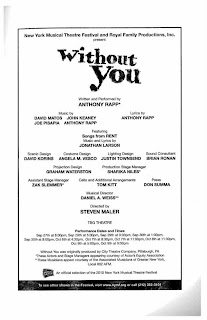NYMF, The Barrow Group Theater
There's a scene from the television series "Six Feet Under" where a grieving woman asks the main character Nate, "Why do people have to die?" Nate considers for a moment and then replies, "To make life important."
There is something about that elemental theme - death giving shape to life - that utterly arrests me. I don't know what it is. It could be just a basic human understanding that life is fleeting. But it feels like more than that. Any story that organizes itself around this theme has the power to reduce me within moments to a quivering, tear-stained ball of emotion. It's like I'm mainlining some essential unbearableness. I become instantaneously raw. And it's not so much the dying part that does it. It's the living part. Living in the face of, the fear or, the wake of, the knowledge of, the acceptance of death - a loved one's or one's own. It's terrible yet beautiful. Death and life sharpening one another. It just undoes me.
That doesn't make me special I realize. But it does explain why I woke up with swollen turtle eyes this morning, a full thirteen hours after seeing Anthony Rapp's one man show Without You. Anthony Rapp originated the role of Mark in the musical Rent, and while that cultural phenomenon was happening to him and around him - a period already underscored by the unexpected death of Rent's creator, Jonathan Larson - Rapp's own mother was living with and eventually dying from cancer. Without You chronicles the layering of these events in Rapp's life, a confluence that is somewhat staggering. Given that I come undone by stories of death giving shape to life, and given my love affair with Rent, itself a narrative organized around this theme, I knew walking into Without You that I was hosed. And I was right. My face was simply lacquered in tears from the beginning right to the end.
Thinking back on Rapp's show, though, I realize there's another element to these narratives that sources the rawness I feel. It's not just how death and life sharpen one another, it's how death and life are each sharpened by love. It's the love. Cheesy as it sounds. When it comes to dying, love is both the source of pain, and the way through it. That seemed to be the message of Rapp's narrative, and it was also so in Rent. I suppose if dying is what makes life important, then what makes life important is love. Hey, just because it comes off cheesy written out like that in some sappy woman's blog, doesn't make it untrue. I've got the turtle eyes to prove it.






